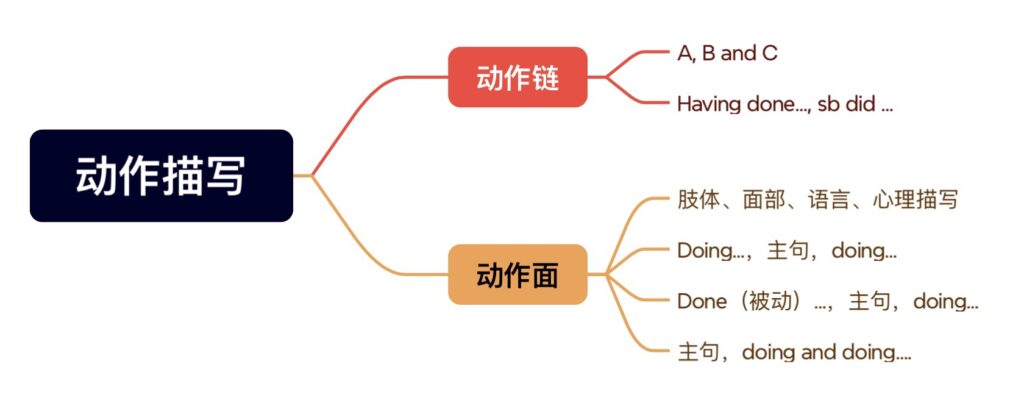动作描写思路
动词是英语语言的主角,很多句子肯定都包含动作的描写。但是我们在描写动作的时候往往会犯一个毛病,那就是太过于单薄。那么该如何将动作构建得饱满?这就是在“动作描写”这一章节中我们要重点展开的问题。
要想把动作写得生动有画面感,主要有两种思路:构造“动作链”和“动作面”。
方法一:构造“动作链”
比如上车这个动作,很多同学不知道该如何刻画细节,会把其写得非常单一,诸如“He got into the car”这样的句子。但实际上,记叙文就像是拍电影,所有的场景都是一帧帧画面连续串接的结果。我们可以把这个简单的动作按时间拆分成一条“动作链”:
【拦车】→【上车】→【告诉司机目的地】
再比如2017年6月浙江卷读后续写中可能会写到“用肉把狼引开”的情节,其中扔肉这个简单的动作同样可以按时间拆分成:
【拿出肉】→【瞄准狼】→【扔出去】
1、“动作链”结构1:A,B and C
中文里允许出现一连串的谓语动词在一个单句中,而英语中是不允许的。因此在拆分构思完动作链后,落实到英文写作时,我们非常依赖连词“and”的使用。我们常常可以用A and B或者A,B and C这两种结构来处理。当然,也没有必要在一个句子中塞进所有的动作,2~4个动作是比较合理的。
比如上文提到的上车的动作链,我们就可以写成:
She hailed a taxi, got into it and told the driver her destination.
而扔肉的动作可以写成:
He pulled out the meat, aimed at the wolf and threw it straight to the fierce animal.
例1:看到失散多年的儿子,她将其一把抱住。
可以把“抱”这个动作按时间拆分为:冲上前,搂人怀中。再用A and B连字成句:
She dashed forward and gathered her son into her arms.
例2:发表获奖感言。
按时间拆分为:先看一眼奖杯,深吸一口气,说道:“谢谢吞吞!”。再用A,B and C 这个结构:
She glanced at the trophy,took a deep breath and said,“Thank TUNTUN!”
此外,A,B and C也不一定都表示连续的动作,有时也可以表示并列,比如下面这两个例子:
例3:We yelled at the bear, hit pots hard and fired blank shotgun shells into the air.
翻译:我们冲着这只熊大喊,猛烈地敲锅,还冲着天上开空枪。
例4:Everynight, lying awake in bed, I waited for the train to stop, waited for the sound of his work boots dropping on the step, and waited for his voice calling,“I’m home!”
翻译:每天晚上,我醒着躺在床上,等待火车到站,等待他的工作靴落在台阶上的声音,等待他说“我到家了”
2、“动作链”结构2:Having done….
动作链除了用连词来成句以外,也能用非谓语衔接动作。
比如,“征战多年后,战士回到家中,发现家人已经搬走了。”可译为:
Having fought in the war for years, the soldier returned to his home only to find his families had moved away.
这句话中的三个动作中,中间的returned 为谓语动词,前后分别用了 having done 和 to do两种非谓语形式。having done 可以表示“已经做了……”,比如这句话中,就强调这个战士在沙场上征战多年后,才回到了家乡。所以havingdone这个结构也可以用于动作链的描写。
例1:排了三个小时的队后,他被告知票卖完了。
“排队”和“被告知”两个动作构成一个动作链,除了用and 连接将句子译为“He queued for 3 hours, and was told that the tickets were sold out.”外,也可以用having done 这个结构,译为“Having queued for 3 hours, he was told that the tickets had been sold out.”
例2:哈利·波特收到光轮2000后高兴得不知所措。
“收到”和“感到高兴”两个动作构成了一个动作链,除了用and连接将句子译为“Harry Potter received the Nimbus 2000 and was so happy that he was at a loss what to do.”以外,也可以用having done 结构,译为“Having received the Nimbus 2000Harry Potter was so happy that hewas at a loss what to do.”
3、“动作链”使用范例
例1:She took a deep breath, leaned on her cane and limped to him.
翻译:她深吸一口气,倚靠着她的拐杖,一瘸一拐地走向他。
例2:We flew at him,jumped all over him, and rolled him in the snow.
翻译:我们向他飞奔过去,跳到他身上,和他在雪中滚成一片。
例3:I raised the javelin over my head, took six quick steps and let the thing go.
翻译:我把标枪高举过头顶,快步向前迈了六步,把它扔了出去。
例4:They looked over, confused for a moment, read my sign and broke into smiles.
翻译:他们看过来,疑惑了一下,读了我的标牌,突然笑了起来。
例5:Within minutes, a young man approached the bench, slipped something into his pocket, and walked off.
翻译:没过多久,一个年轻人走到长凳前,把某样东西塞进自己的口袋,然后走开了。
例6:But the wolf clamped its jaw onto Matt’s arm, set its powerful legs, and began tugging(用力拖) Matt outside.
翻译:但是这只狼用嘴死死咬住 Matt的手臂,迈动有力的双腿开始把 Matt拖了出去。
例7:He grasped the trumpet, turned sharply in the air, flew out through the hole in the window and over the roofs of Billings city.
翻译:他抓住这只小号,在空中打了个急转,从窗户的破洞中飞出,掠过比利斯城上空。
例8:He stood up, hugged his parents, and smiled, trying not to let his emotions get the better of him.
翻译:他站了起来,抱住父母,微笑着,尽量不让情绪失控。
例9:I got a feel for how the world of finance functioned, made new friends, and generally enjoyed the mostly easy-going work surroundings.
翻译:我对于金融世界的运行有了了解,结交了新的朋友,还大体享受了近乎悠闲的工作环境。
例10:Even Mei Mei was in a good mood as she rushed around, seating guests, handing out menus, and pouring water.
翻译:就连 Mei Mei 也开心地到处跑,招呼客人落座,分发菜单,给客人倒水。
方法二:编织动作“面”
上文讲到按时间把单一动作拆分成一连串的动作链,就像电影里的补帧一样。同样向电影学习,我们还可以在同一时间点,安排多个摄像机在不同角度拍摄,然后把不同的镜头剪接在一起,构成一个饱满的动作面。
比如:Aragorn 面带杀气,振臂一挥,大喊:“放箭!”。该句分别从面部表情、肢体动作和语言的角度进行刻画,从而把整个场景编制成一个饱满的动作面。
再比如:贝贝坐在泳池边,双臂低垂,眺望远方,思考自己是白熊猫还是黑熊猫。本句中的“坐在”“低垂”“眺望”“思考”,就是分别从肢体动作、面部表情、心理活动的角度对人物进行刻画,构造动作面,让贝贝此刻深沉的形象跃然纸上。
总结一下,我们可以从整体到局部,从肢体、面部到语言心理,从多个角度去描绘一个场景,构造动作面。而构造动作面时,最常使用的语法结构就是非谓语动词,以下列举一些比较好用的句式:
①Doing…,主句,doing …
如“黄昏下站着一对恋人”这个场景,我们可以从三个角度进行描写:肢体动作上,他们站在空旷的路边;面部表情上,他们仰望着天空;心理活动上,他们感受着这份珍贵的平静。
三个主动动作同时进行,可以用“doing,谓语动词,doing”句式,即译为:
Standing beside the empty road, they looked up into the sky, feeling the precious peace from within.
练习:围在营火旁,他们吃着烧烤,享受这一令人难忘的时光。
______________________________________________________________________
答案:Gathering around the campfire, they feasted on BBQ, enjoying the unforgettable moment.
②Done…,主句,doing …
如“Lucy举手回答问题”这个场景,从心理活动、肢体动作、语言三个角度,可以拆分成:被老师的话所鼓舞,Lucy举起了手,小声说,“我来。”由于“被鼓舞”是被动动作,因此此处应该用的是“done,谓语动词,doing”句式,即译为:
Encouraged bythe teacher’s words, Lucy raised her hand, whispering,“I’ll do it.”
练习:被眼前的这一幕吓坏了,他一动不动,不知道该说什么。
_____________________________________________________________________
答案:Terrified by the scene in front of him, he was rooted to the spot, being at a loss what to say.
③主句,doing … and doing …
Gene Kelly在《雨中曲》中的一段在雨中跳舞的表演堪称经典,从心理活动、肢体动作两个角度可以拆分成:他欣喜若狂,在雨中又唱又跳。其中“又唱又跳”可以用doing and doing的结构,即译为:
He was overwhelmed with joy, singing and dancing in the rain.
练习:他激动地鼓掌,一边点头,一边微笑。
___________________________________________________________________
答案:He clapped his hands with excitement, nodding and smiling.
④(With)… doing/ done…,主句,doing …
回看前文提到的关于贝贝的例子: 贝贝坐在泳池边,双臂低垂,思考自己是白熊猫还是黑熊猫。其中“坐”和“思考”两个动作的发出者都是贝贝,但是“低垂”动作的发出者并不是贝贝。因此这句话如果译为“Drooping, BeiBei sat beside the pool, wondering whether he was white or black.”则是有问题的,其中的“低垂(drooping)”这个动作并非主句的主语“贝贝”做的。
故应该在drooping前面加上动作的发出者“双臂”,即译为:
(With)his arms drooping, BeiBei sat beside the pool, wondering whether he was white or black.
又例如“一个人靠在树上”这一简单的动作可以拆分为如下的一系列动作“面”:
他【头耷拉】着,【背靠】在树上,【反思】之前发生的一切。
(With)his head drooping, he leaned on the tree, reflecting on what had happened.
⑤“动作面”使用范例
例1:They were having a wonderful timetalking, eating and joking.
翻译:他们享受着美好的时光,聊着天,吃着东西,开着玩笑。
例2:(Being)speechless and disappointed, Tim stood there not knowing what to do with it.
翻译:失望、无言,Tim 站在那里,不知道该怎么办。
例3:I ran up and down the aisles in the dark, panic filling my small chest and making it difficult to breathe.
翻译:我在黑暗的过道中跑来跑去,惊慌充斥着我的小胸膛,让我难以呼吸。
例4:She held him up to the window, stretching him out by his two arms and whispering into his nonexistent ear,“Bib-bibs,Dumpty,bib-bibs!”
翻译:她把他抱到窗边,拽着他的双臂伸出窗外,并且在他并不存在的耳边说:“小鸟,Dumpty,小鸟!”
例5:Approaching the table, in spite of her trembling hands, Mei Mei managed to curve her lips into an elegant arc, and said,“Welcome to my restaurant. Here are some cookies for you.”
翻译:走近桌子,尽管双手颤抖,Mei Mei 还是把嘴唇弯成了一道优雅的弧线,并且说:“欢迎来到我的饭店。这是给你们的饼干。”
Mindmap解析
